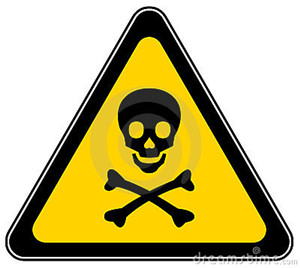(单词翻译:单击)

INTRO: Caution! Warning! The signs are all around us! This week VOA's Wordmasters Avi Arditti and Rosanne Skirble look behind the labels on hazardous materials to find out what it takes to put danger into words.
SFX: Pouring sound
AA: OK, now pour in some stuff from that bottle over there.
RS: That bottle without a label?
AA: Right — it's probably safe.
RS:OK.
SFX: Glass smashing
RS: Uh oh.
SFX: Explosion
RS: Time to talk to an expert about hazard communication!
AA: Sidney Lirtzman is acting president of Baruch College at City University of New York. His research has focused on hazard communication in the chemical industry. He says a lot of people think it's easy to write a warning for, say, a corrosive chemical.
TAPE: CUT 1 - LIRTZMAN
"And you'd say, 'so what, it's very straightforward, you tell them you could burn yourself.'"
RS: But, in fact, he says, creating an effective warning takes a lot more work.
TAPE: CUT 2 - LIRTZMAN
"It's got to communicate very rapidly to a person who sees it without very much concentrated reading or concentrated attempts at deciphering what the thing is actually saying. And to do that requires a considerable amount of planning as to what words to use, how the words will be strung together in a sentence, what the tone of the sentence will be, whether the words or the sign should be in color, whether there should be symbols associated with it or not associated with it."
AA: Sidney Lirtzman says hazard communicators also have to consider the ability of intended audiences to understand and apply what they read. He says the United States has a high level of functional illiteracy, both among native English speakers and non-native populations.
TAPE: CUT 3 - LIRTZMAN
"You cannot be certain as to the actual reading level capability of many people. So the attempt is being made to reduce the complexity of English which is being used in warnings down to at least a sixth-grade level — and below if possible — and also to make certain that under certain circumstances, warnings may be repeated and appear not only in English but may be repeated to a large extent in Spanish."
RS: Sidney Lirtzman says warning signs intended for multicultural audiences increasingly use symbols in place of words. He says, for instance, that most people recognize skull- and-cross-bone symbols to mean a poison or toxic hazard.
AA: But ten years ago he led a study which found that many commonly used chemical hazard signs were misunderstood. One sign was especially confusing: the silhouette of a man with white dots on his body.
RS: The sign warns about a potentially severe allergic reaction to contact with a chemical. But that's not how people in the study saw it.
TAPE: CUT 4 - LIRTZMAN/ARDITTI
"The most common association which was made and the understanding that they had was that it was a sign for a men's room."
AA: "Have they changed that symbol or any of the others that were confusing?"
LIRTZMAN: "Mainly what has been done is to try to avoid using it."
RS:Professor Lirtzman says the problem is finding a better alternative.
AA: And, there's another hazard looming: the Y2K bug. By now most people have heard the warnings that some computers may think the year 2000 is actually the year 1900, and malfunction.
RS: Sidney Lirtzman says hazard communicators should now have detailed plans ready to instruct people what to do in a Y2K emergency.
TAPE CUT 5 - LIRTZMAN
"This should have been done a long time ago, and if it hasn't been done by now, I couldn't see what good it would do to start fooling around now."
AA: That was hazard communications expert Sidney Lirtzman.
RS: Now for our own alert — beginning in the New Year we're introducing a new segment on Wordmaster with "Grammar Lady." So send us your grammar questions along with any other questions or comments. Send them to word@voa.gov or to VOA Wordmaster, Washington DC 20547 USA.
AA: Finally, if you still can't decide what to call the coming decade — in other words, what follows the 'Nineties? — then listen at this time next week. We'll replay the winning entries in our Wordmaster Name the Next Decade Contest.
RS: With Avi Arditti, I'm Rosanne Skirble wishing you a hazard-free New Year!
MUSIC:"WILL2K"/Will Smith
词汇点津:
今天的《词汇大师》讨论了危险警告语的应用。警示,警告语在我们的生活中随处可见,比如corrosive chemical腐蚀性化学品等。警告语告诉我们什么可以做,什么不可以做,在我们的生活中十分重要。因此,警告语的设计可是大有学问的。比如,字体,颜色和警示标志都要仔细考量。
警示语的语言更是重中之重,我们要考虑到语言的难易水平和逻辑应用性。譬如,不同的人理解水平良莠不齐,这就要求警示语必须简单易懂;不同的地域所用语言不尽相同,这就要求有的地方要用双语甚至是多语的警示语。
还有警示标志一定是通俗易懂的,比如一个骷髅头加上两条交叉的骨头代表有毒物品。而人们表示有许多标示都是不常见的,人们最为熟悉的就是卫生间的标志。


